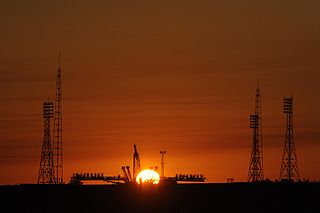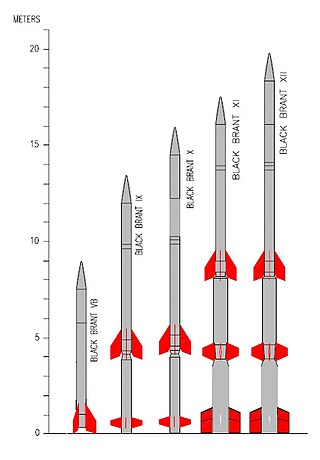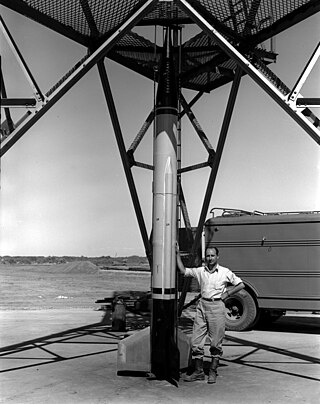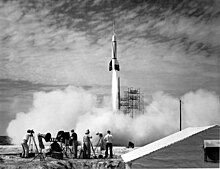
The Jupiter-C was an American research and development vehicle developed from the Jupiter-A. Jupiter-C was used for three uncrewed sub-orbital spaceflights in 1956 and 1957 to test re-entry nosecones that were later to be deployed on the more advanced PGM-19 Jupiter mobile missile. The recovered nosecone was displayed in the Oval Office as part of President Dwight D. Eisenhower's televised speech on November 7, 1957.

A spaceport or cosmodrome is a site for launching or receiving spacecraft, by analogy to a seaport for ships or an airport for aircraft. The word spaceport, and even more so cosmodrome, has traditionally been used for sites capable of launching spacecraft into orbit around Earth or on interplanetary trajectories. However, rocket launch sites for purely sub-orbital flights are sometimes called spaceports, as in recent years new and proposed sites for suborbital human flights have been frequently referred to or named "spaceports". Space stations and proposed future bases on the Moon are sometimes called spaceports, in particular if intended as a base for further journeys.

The Aerobee rocket was one of the United States' most produced and productive sounding rockets. Developed by the Aerojet Corporation, the Aerobee was designed to combine the altitude and launching capability of the V-2 with the cost effectiveness and mass production of the WAC Corporal. More than 1000 Aerobees were launched between 1947 and 1985, returning vast amounts of astronomical, physical, aeronomical, and biomedical data.

Saturn-Apollo 3 (SA-3) was the third flight of the Saturn I launch vehicle, the second flight of Project Highwater, and part of the American Apollo program. The rocket was launched on November 16, 1962, from Cape Canaveral, Florida.

A multistage rocket or step rocket is a launch vehicle that uses two or more rocket stages, each of which contains its own engines and propellant. A tandem or serial stage is mounted on top of another stage; a parallel stage is attached alongside another stage. The result is effectively two or more rockets stacked on top of or attached next to each other. Two-stage rockets are quite common, but rockets with as many as five separate stages have been successfully launched.

A sub-orbital spaceflight is a spaceflight in which the spacecraft reaches outer space, but its trajectory intersects the surface of the gravitating body from which it was launched. Hence, it will not complete one orbital revolution, will not become an artificial satellite nor will it reach escape velocity.

The Black Brant is a family of Canadian-designed sounding rockets originally built by Bristol Aerospace, since absorbed by Magellan Aerospace in Winnipeg, Manitoba. Over 800 Black Brants of various versions have been launched since they were first produced in 1961, and the type remains one of the most popular sounding rockets. They have been repeatedly used by the Canadian Space Agency and NASA.

Viking was a series of twelve sounding rockets designed and built by the Glenn L. Martin Company under the direction of the U.S. Naval Research Laboratory (NRL). Designed to supersede the German V-2, the Viking was the most advanced large, liquid-fueled rocket developed in the United States in the late 1940s, returning valuable scientific data from the edge of space between 1949 and 1955. Viking 4, launched in 1950, was the first sounding rocket to be launched from the deck of a ship.

The North American SM-64 Navaho was a supersonic intercontinental cruise missile project built by North American Aviation (NAA). The final design was capable of delivering a nuclear weapon to the USSR from bases within the US, while cruising at Mach 3 at 60,000 feet (18,000 m) altitude. The missile is named after the Navajo Nation.

The WAC Corporal was the first sounding rocket developed in the United States and the first vehicle to achieve hypersonic speeds. It was an offshoot of the Corporal program, that was started by a partnership between the United States Army Ordnance Corps and the California Institute of Technology in June 1944 with the ultimate goal of developing a military ballistic missile.

The RTV-A-2 Hiroc was a product of the United States' first effort to develop an intercontinental ballistic missile (ICBM). The project was named MX-774. The project was canceled in 1947, but leftover funds were used to build and launch three of the planned 10 research vehicles designated RTV-A-2. The design included several innovations; the gimbaled thrust chambers provided guidance control, the internal gas pressure was used to support the airframe and the nose cap was separable. All of these concepts were later used on the Atlas missile and the first two on the Viking rocket. Also developed as part of MX-774 was the Azusa guidance system which was not used on the Hiroc missile but did contribute to the Atlas missile as well as many other early guided missiles launched from Cape Canveral.

Spaceflight as a practical endeavor began during World War II with the development of operational liquid-fueled rockets. Beginning life as a weapon, the V-2 was pressed into peaceful service after the war at the United States' White Sands Missile Range as well as the Soviet Union's Kapustin Yar. This led to a flourishing of missile designs setting the stage for the exploration of space. The small American WAC Corporal rocket was evolved into the Aerobee, a much more powerful sounding rocket. Exploration of space began in earnest in 1947 with the flight of the first Aerobee, 46 of which had flown by the end of 1950. These and other rockets, both Soviet and American, returned the first direct data on air density, temperature, charged particles and magnetic fields in the Earth's upper atmosphere.

Project Hermes was a missile research program run by the Ordnance Corps of the United States Army from November 15, 1944, to December 31, 1954, in response to Germany's rocket attacks in Europe during World War II. The program was to determine the missile needs of army field forces. A research and development partnership between the Ordnance Corps and General Electric started November 20, 1944 and resulted in the "development of long-range missiles that could be used against both ground targets and high-altitude aircraft."

USS Desert Ship (LLS-1) is a concrete blockhouse providing assembly and launch facilities simulating shipboard conditions for Navy surface-to-air weapons testing at the Naval Air Warfare Center (NAWC) Weapons Division – White Sands.

Vanguard TV-3BU, also called Vanguard Test Vehicle-Three Backup, was the second flight of the American Vanguard rocket. An unsuccessful attempt to place an unnamed satellite, Vanguard 1B, into orbit, the rocket was launched on 5 February 1958. It was launched from LC-18A at the Cape Canaveral Air Force Station. Fifty-seven seconds after launch, control of the vehicle was lost, and it failed to achieve orbit. At 57 seconds, the booster suddenly pitched down. The skinny second stage broke in half from aerodynamic stress, causing the Vanguard to tumble end-over-end before a range safety officer sent the destruct command. The cause of the failure was attributed to a spurious guidance signal that caused the first stage to perform unintended pitch maneuvers. Vanguard TV-3BU only reached an altitude of 6.1 km (3.8 mi), the goal was 3,840 km (2,390 mi).

German V-2 rockets captured by the United States Army at the end of World War II were used as sounding rockets to carry scientific instruments into the Earth's upper atmosphere, and into sub-orbital space, at White Sands Missile Range (WSMR) for a program of atmospheric and solar investigation through the late 1940s. Rocket trajectory was intended to carry the rocket about 100 miles (160 km) high and 30 miles (48 km) horizontally from WSMR Launch Complex 33. Impact velocity of returning rockets was reduced by inducing structural failure of the rocket airframe upon atmospheric re-entry. More durable recordings and instruments might be recovered from the rockets after ground impact, but telemetry was developed to transmit and record instrument readings during flight.

Vanguard TV-0, also called Vanguard Test Vehicle-Zero, was the first sub-orbital test flight of a Viking rocket as part of the Project Vanguard.

Vanguard TV-1, also called Vanguard Test Vehicle-One, was the second sub-orbital test flight of a Vanguard rocket as part of the Project Vanguard. Vanguard TV-1 followed the successful launch of Vanguard TV-0 a one-stage rocket launched in December 1956.

Vanguard TV-2, also called Vanguard Test Vehicle-Two, was the third suborbital test flight of a Vanguard rocket as part of Project Vanguard. Successful TV-2 followed the successful launch of Vanguard TV-0 a one-stage rocket launched in December 1956 and Vanguard TV-1 a two-stage rocket launched in May 1957.

Vanguard SLV-3, also called Vanguard Satellite Launch Vehicle-3 hoped to be the second successful flight of the American Vanguard rocket following successful Vanguard 1 satellite on rocket Vanguard TV-4.

























